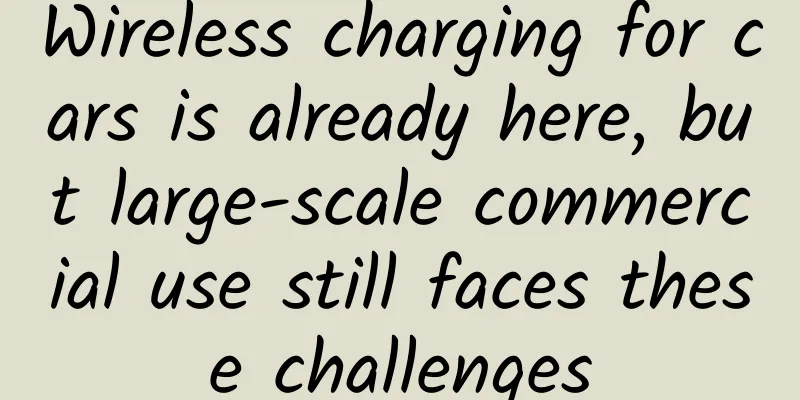Wireless charging for cars is already here, but large-scale commercial use still faces these challenges

|
Nowadays, wireless charging technology is no longer a new thing for the public. Infinite charging has been applied to many mobile phones. However, in the automotive field, wireless charging is still very rare. Currently, only a few models such as BMW 550e and Roewe Marvel X support wireless charging. There are many unique requirements for wireless charging of cars: Since electric vehicles have large batteries, the charging time must be as short as possible, so the charging system needs to have several kilowatts or even tens of kilowatts of power; the size of the charging coil should match the car as much as possible and be as light as possible; the distance of wireless charging of cars is determined by the distance between the car and the ground, which is very different from wireless charging of mobile phones; since wired charging is extremely efficient, wireless charging must achieve an efficiency of at least 85% to be commercially viable. With the promotion of electric vehicles and the advancement of power electronics and battery technology, wireless charging of cars has gradually attracted public attention. Wireless power transmission can be classified into five categories according to the transmission distance: microwave, laser, ultrasonic, electric field coupling and magnetic field coupling. These technologies can be divided into two categories: far field and near field. Far-field technology is more suitable for long-distance, low-efficiency power transmission; while near-field technology is more suitable for short-distance wireless power transmission due to its close-range and high-efficiency characteristics. If car wireless charging is divided into two categories, static wireless charging and dynamic wireless charging, they can be considered the difference between parking charging and driving charging. If we stay at static wireless charging, compared with wired charging, its main advantage is convenience. Although the efficiency of wireless power transmission has reached a relatively high level, it is still lower than wired charging. There are still some problems to be solved in static wireless charging. For example, how to detect and eliminate foreign objects in the coils at both ends of the charging? If any metal parts fall into the fallen leaves between the two coils, it may cause a fire. If there are living animals such as cats and dogs in the two coils, high-power transmission will also pose a great safety threat to the animals. Dynamic wireless charging does not have the above problems, but it is extremely expensive to implement and requires major renovation and maintenance of an entire road. The lack of technical standards has also limited the popularization of this technology. The establishment of automotive wireless charging technology standards is not only a task for the automotive field, but also requires the revision of relevant domestic and foreign electromagnetic management standards and regulations; in addition, it is necessary to report to international electromagnetic organizations at the same time to ensure that the radio waves in the relevant frequency bands will not be affected. There is no definite theory to show the extent of harm of electromagnetic radiation to the human body. However, for the public, electromagnetic radiation itself is a "sensitive word", and whether wireless charging can be accepted by the public also remains to be seen. Auto giants such as Toyota, Nissan, Honda, and BMW; suppliers such as Bosch, Qualcomm, Huawei, ZTE, and other companies have all vigorously promoted wireless charging. As a winner of Toutiao's Qingyun Plan and Baijiahao's Bai+ Plan, the 2019 Baidu Digital Author of the Year, the Baijiahao's Most Popular Author in the Technology Field, the 2019 Sogou Technology and Culture Author, and the 2021 Baijiahao Quarterly Influential Creator, he has won many awards, including the 2013 Sohu Best Industry Media Person, the 2015 China New Media Entrepreneurship Competition Beijing Third Place, the 2015 Guangmang Experience Award, the 2015 China New Media Entrepreneurship Competition Finals Third Place, and the 2018 Baidu Dynamic Annual Powerful Celebrity. |
Recommend
Take the example of collecting five blessings: How to plan a super marketing campaign?
What is super marketing? [Super Marketing] is the...
Case analysis: How to increase user growth?
During the survey, we found that “growth means” i...
The latest news on the next round of oil price adjustment in 2022: Will the next adjustment be an increase or a decrease? Attached is the latest oil price adjustment schedule
Recently, domestic oil prices have become the mos...
An inventory of the characteristics of major information flow channels such as Baidu and Tencent, save it now!
With the development of social media , Weibo, Ten...
What are the “invisible hands” driving those unicorns onto the path of mergers?
[[152580]] Paypal merged with X.com between Febru...
How to do Valentine's Day marketing? Here are 6 tips for you!
Is Valentine’s Day Marketing Important? This time...
These Winter Olympics events are most prone to injuries! How to prevent them?
As the opening of the Beijing Winter Olympics dra...
"Old people use 9 keys, young people use 26 keys"? Your typing habits have betrayed you...
Just like the never-ending "sweet and salty&...
Inventory of essential tools for new media operations (dry goods collection)
We also need to arrange a good-looking layout How...
Mobile games are moving towards the era of "alliances"丨The 5th Global Mobile Games Conference will be held in March
With the rapid popularization of smart phones and ...
How should the Internet finance APP be promoted?
As the saying goes, traffic is as valuable as gol...
Why do girls always have bruises on their bodies when they wake up?
"Honey, what did you do last night? Why is t...
rua Can I pet a tiger if I'm allergic to cats? Tiger: Are you polite?
What is it like to encounter a tiger just when yo...
Didi ToB business full case review
When Yidao first started offering private cars ar...
How could a reinforced concrete bridge across the Taiwan Strait be easily destroyed by the wind?
Bridges made of reinforced concrete are very stro...









